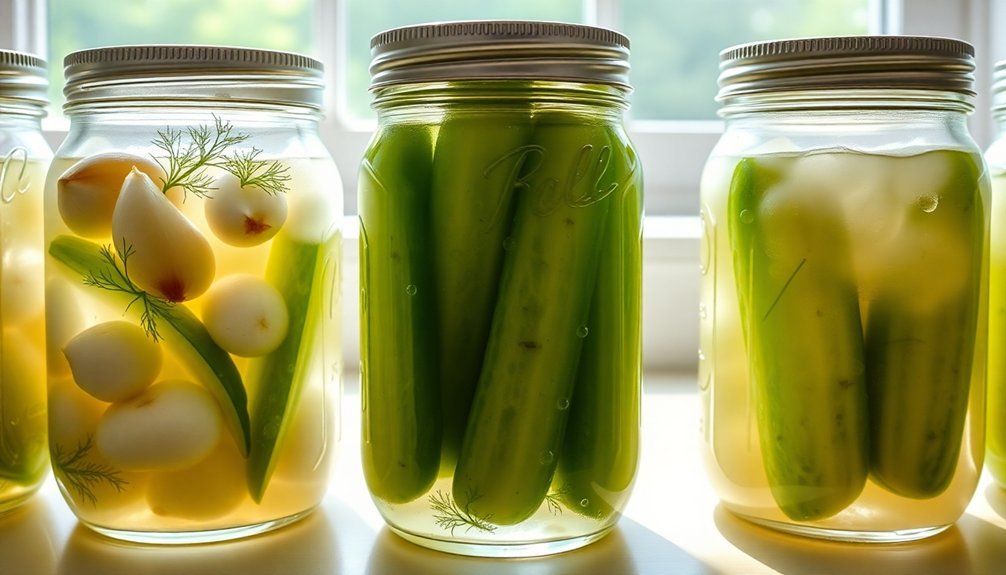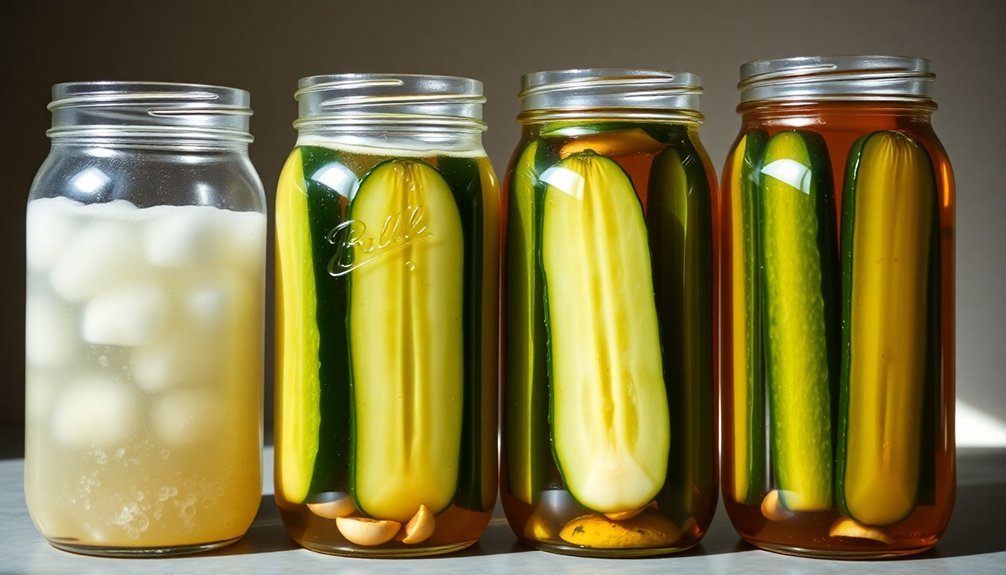You'll find three perfect fermentation timelines for homemade pickles: a quick five-day method for crisp, lightly fermented cucumbers, a two-week traditional process for balanced, tangy results, or a four-week extended fermentation for intensely sour pickles. Each method requires proper pickling cucumbers, a 2-3% salt brine, and temperatures between 65-75°F. For any timeline, you'll need to remove the blossom ends, use non-iodized salt, and keep the cucumbers fully submerged. Watch for bubbles and cloudy brine as signs of successful fermentation. The journey to pickle perfection holds many more fascinating details and techniques.
Quick Five-Day Fermented Pickles

A jar of crisp, tangy pickles is just five days away with this quick fermentation method.
You'll need pickling cucumbers, not the standard slicing variety, and you'll want to start by cutting off the blossom end to maintain crunchiness. Create a 2-3% salt brine solution and add your favorite seasonings like garlic and dill. This traditional method creates nutrient-rich probiotics that support digestive health.
Set up your fermentation station in a room that's between 65-75°F, away from direct sunlight and household appliances. Make sure your cucumbers are fully submerged in the brine before sealing the jar. If you're using a regular lid, you'll need to burp it daily to release built-up gases.
Watch for signs that fermentation is working: bubbles rising in the brine, cloudiness developing, and subtle color changes in the cucumbers.
After five days, taste your pickles. They should have a pleasant tang, but if you'd like them stronger, let them ferment longer. Once you're satisfied with the taste, transfer them to the refrigerator with a standard lid. The cold temperature will slow down fermentation and help preserve your pickles' perfect flavor.
Two-Week Traditional Pickle Fermentation
Traditional two-week fermentation produces deeply flavored, probiotic-rich pickles that develop complex tastes over time.
You'll need to start by selecting English, pickling, or Persian cucumbers, trimming their blossom ends, and creating a salt brine. Avoid using table salt as iodine interferes with the fermentation process. Pack your cucumbers tightly with dill, shallot, thyme, and pickle spices in a jar, ensuring they're fully submerged with a fermentation weight.
The fermentation process follows three distinct phases:
- Days 1-3: Your pickles begin their transformation as you maintain proper submersion and monitor for initial bacterial activity. Keep the jar at room temperature (60-75°F) away from direct sunlight.
- Days 4-7: You'll notice bubbling activity, cloudy brine, and color changes from bright to olive green. The environment becomes ideal for beneficial *Lactobacillus* bacteria.
- Days 8-14: The fermentation peaks as *Lactobacillus* dominates, producing the signature tangy flavor through lactic acid production.
Once you're satisfied with the taste after day 14, transfer your pickles to the refrigerator.
You can add vinegar if desired, but it's not necessary. They'll continue to develop flavor while staying preserved in cold storage.
Extended Four-Week Sour Pickles

Extended fermentation produces intensely sour, full-bodied pickles that develop a distinctive tang over four weeks. During this longer process, you'll need to maintain ideal temperatures between 60°F to 75°F to guarantee proper fermentation, as temperature fluctuations can affect the speed of the process.
Start with small, unwaxed cucumbers – English, pickling, or Persian varieties work best. Don't forget to remove the blossom end and cut them into your preferred shape, whether that's spears, slices, or halves. These pickles serve as a low-calorie snack alternative while delivering robust flavor.
You'll want to prepare a room-temperature brine using Celtic or kosher salt, then add fresh dill, garlic, and optional spices like mustard seeds and peppercorns according to your taste preferences.
Throughout the four-week period, you'll need to maintain your fermentation daily. Keep the cucumbers submerged using a fermentation weight and burp the jars to release excess gases.
While the minimum fermentation time is 5-7 days, extending to four weeks will yield increasingly sour results. Once you've achieved your desired sourness level, transfer the pickles to the refrigerator to slow down the fermentation process.
Frequently Asked Questions
Can I Save and Reuse the Brine From a Successful Batch of Fermented Pickles?
Yes, you can reuse pickle brine for multiple fermentation batches. Add 1/2 cup of old brine to a quart jar when starting new pickles. Just make sure it's not cloudy or smelly first.
What Causes Pickles to Become Hollow or Have Hollow Centers During Fermentation?
Your pickles can become hollow if you don't process them quickly after harvest, use poor-quality cucumbers, maintain incorrect brine strength, or have improper fermentation temperatures. It's essential you pickle within 24 hours.
How Do I Prevent White Film or Kahm Yeast on My Fermenting Pickles?
You'll prevent kahm yeast by maintaining proper acidity, using adequate salt, controlling temperature (72-78°F), and minimizing oxygen exposure. Keep your pickles fully submerged in brine and use clean equipment and ingredients.
Should I Remove Scum That Forms on Top During the Fermentation Process?
Yes, you'll want to remove any scum that forms on top of your fermenting pickles. It's best to skim it off daily with a small spoon to maintain proper acidity and prevent potential spoilage.
Why Do My Fermented Pickles Turn Out Too Soft or Mushy?
Your pickles may be turning mushy because you're using the wrong cucumber variety, skipping tannins like grape leaves, or fermenting at too high temperatures. Don't forget to remove flower ends and maintain proper salinity.
In Summary
Whether you're making quick five-day pickles, traditional two-week ferments, or tangy four-week sours, you'll find the perfect fermentation time to match your taste preferences. Each duration creates distinct flavors and textures, from crisp and mild to deeply complex and sour. Start with the shorter ferments if you're new to pickling, then experiment with longer times as you develop your fermentation skills.





Leave a Reply